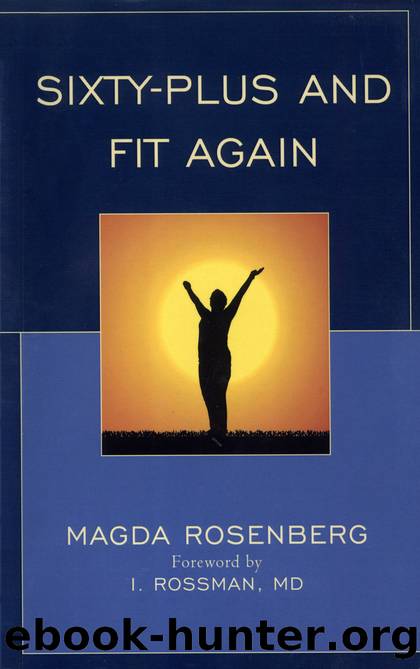Sixty-Plus and Fit Again by Rosenberg Magda;Rossman I. M.D.;Wilson Hoke;

Author:Rosenberg, Magda;Rossman, I., M.D.;Wilson, Hoke;
Language: eng
Format: epub
ISBN: 9781590775158
Publisher: M. Evans & Company
Published: 2015-09-29T00:00:00+00:00
Remember to sit properly, with shoulders and buttocks against the back of the chair (and avoid soft, overstuffed chairs, which are luxuries our spines canât afford).
Awareness is important. Be aware of your posture while you are sitting, standing, or walking. It does no good to make a joint flexible, or a muscle strong, if you defeat the purpose of exercise by slouching and drooping for the remaining hours of the day.
Your Capacity for Exercise
Everyone has a different capacity for exercise. No standard applies to all of us. The daily minimum that is right for you must be measured by your physical capabilities, the point at which you reach exhaustion, your rate of breathing, and your pulse rate.
The simplest way to determine your capacity for exercise is to judge when you start breathing heavily after an exercise like walking. If it takes only minutes to make you breathe hard, your capacity is low, so when you begin doing exercises, you should limit yourself to only a few minutes a day.
For both muscle-toning and flexibility exercises, you will have to discover what your capacity is. Itâs dangerous, for example, to overdo muscle-toning exercises. You could be bedridden for weeks if you donât follow directions and listen to your body. A muscle that hasnât been used for years is sick, and unless you treat it with loving care, as you try to get it back into shape, the result could be serious.
An unused muscle can be brought back to life, even after years of disuse. It needs to be used steadily and slowly, however, to bring it back to health.
Start by working each set of muscles for no longer than two minutes a day for the first few weeks. Muscles donât hurt while you are exercising them. The reaction to waking up those tired muscles and putting them to work usually comes the day after you start. Thatâs when you might feel some aches and pains. But youâll be defeating your purpose, and possibly harming yourself, if you overdo your exercises the first weeks of a program. Donât let enthusiasm run away with you. Thereâs nothing to be gained from a dayâs strenuous exercise followed by three days in bed to recover.
Start off with a few minutes of exercise, and then wait until the next day to see your bodyâs reaction to the workout. If you have no reactionâno sore muscles or stiffnessâgo ahead with the groups of exercises outlined in later chapters, extending your time by a minute for each one. Each day tone the muscles and exercise your joints a little longer, judging how much you can do by your bodyâs reaction the next day. If you are very stiff and sore, donât increase your time, but donât be too easy on yourself.
You can never go wrong by starting off very slowly and paying attention to your bodyâs signals. Of course, if at any time during exercise you find that it is painful or exhausting, sit down and relax. You have probably reached your limit, and if there is much pain, you should see your doctor.
Download
This site does not store any files on its server. We only index and link to content provided by other sites. Please contact the content providers to delete copyright contents if any and email us, we'll remove relevant links or contents immediately.
Tools of Titans by Timothy Ferriss(7850)
Bodyweight Strength Training by Jay Cardiello(7686)
Born to Run: by Christopher McDougall(6914)
Inner Engineering: A Yogi's Guide to Joy by Sadhguru(6466)
Asking the Right Questions: A Guide to Critical Thinking by M. Neil Browne & Stuart M. Keeley(5389)
The Fat Loss Plan by Joe Wicks(4640)
Bodyweight Strength Training Anatomy by Bret Contreras(4491)
Yoga Anatomy by Kaminoff Leslie(4117)
Science and Development of Muscle Hypertrophy by Brad Schoenfeld(3979)
Dynamic Alignment Through Imagery by Eric Franklin(3936)
ACSM's Complete Guide to Fitness & Health by ACSM(3835)
The Four-Pack Revolution by Chael Sonnen & Ryan Parsons(3808)
Exercise Technique Manual for Resistance Training by National Strength & Conditioning Association(3800)
Bodyweight Strength Training: 12 Weeks to Build Muscle and Burn Fat by Jay Cardiello(3788)
Yoga Anatomy by Leslie Kaminoff & Amy Matthews(3755)
The Ultimate Bodybuilding Cookbook by Kendall Lou Schmidt(3725)
Yoga Therapy by Mark Stephens(3579)
Nutrition for Sport, Exercise, and Health by Spano Marie & Kruskall Laura & Thomas D. Travis(3568)
Nutrition for Sport, Exercise, and Health by Marie Spano & Laura Kruskall & D. Travis Thomas(3562)
